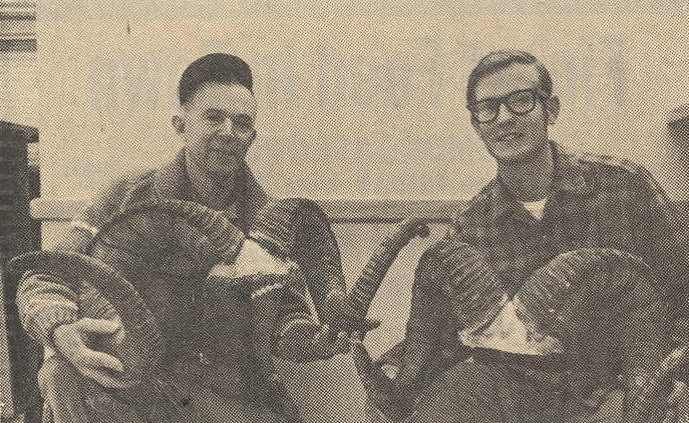UPDATED JANUARY 26th 2021
Could it be true? The Alaska Department of Fish & Game just recently announced that Movi has been found in Alaskan Dall sheep and mountain goats in several mountain ranges across the state.
Could this be the beginning of the end?
Beautiful Brooks Range Ram
The pathogen Mycoplasma ovipneumoniae or Movi for short is a dangerous respiratory bacteria linked to devastating outbreaks of pneumonia in bighorn sheep populations across the western states.
There are many strains of Movi, but the vast majority have proven fatal to bighorn sheep among other species of Caprinae, namely mountain goats and muskoxen.
Here in the north, the Alaska Wild Sheep Foundation embarked on a historic effort in late 2016 to begin raising awareness about Movi and the potential impact it could have on Alaskan Dall sheep.
Buster Combs and John Hemming with Wrangell Mountain Trophy Rams from the mid-70s
The history of Movi likely dates back centuries, but it was in the early 1970s when it was first described in the scientific literature as a pneumonia causing pathogen in domestic sheep. Since then, hundreds of strains of Movi have been isolated from the nasal cavities of domestic sheep and goats across the world. Movi has been found on every continent except Antarctica.
Alaska’s historical domestic sheep population. We’re in a much better situation now risk wise, wouldn’t you say?
Given the widespread occurrence of Movi, it's no surprise that bighorn sheep from Washington to Texas have been exposed to Movi over the years through chance interactions with domestic sheep and pack goats. It only takes one close encounter for the respiratory pathogen to pass between animals. Incubation may take weeks to months, leading to delayed respiratory problems.
Discovering the source of individual transmissions has been difficult, but with genotyping now available for the bacteria, many such transmissions have been documented. Given the relatively few number of strains of Movi found in bighorn sheep, scientists are now more confident than ever the pathogen was not endemic in wild sheep herds in North America prior to the arrival of domesticated Caprinae.
Many domestic sheep and goats are carriers of this pathogen, though show no outward signs of illness. This is what makes it so dangerous to our naive Caprinae. I have yet to meet an owner of a domestic sheep or goat that doesn't care about our wild sheep and goat populations, but it's the bridge they must cross that's causing such consternation on this issue.
Here are the facts. Domestic sheep and goats carry Movi in Alaska, as they do elsewhere. In Alaska, roughly 4% of domestics are believed to carry it. To date, DEC has tested 656 domestic sheep and goats on 43 farms. Of these, Movi was found on 11 of 43 farms (26 %), more so on sheep farms vs. goat. As of September 2020, DEC reported that 25 individual sheep and goats had tested positive for Movi (3.8%). With less than 2000 domestic sheep and goats in the state, this is a relatively small number, but it's important to recognize that it's present.
Also known at this time, of 11 individual positive domestic samples genotyped, 10 different strains of Movi were found. While we hope to learn more about these strains in coming months, this is outright concerning.
As for our wild populations, until 2018, analysis of hundreds of Dall sheep nasal swab and blood samples from the previous decade had all been clean - no sign of the pathogen or any past exposure to the pathogen. All these samples have been run at credible diagnostic labs familiar with Movi.
Then out of the blue, in 2018, a USDA Agricultural Research Services lab reported that Movi was present in Dall Sheep as well as caribou and moose populations across Alaska, with their lead USDA researcher, along with our ADF&G wildlife vet and our DEC state vet rushing to publication without even confirming their results through a diagnostic lab experienced with Movi. Further, it was learned that the lead author actually requested that the most well-known Movi researcher (Dr. Tom Besser, her past advisor) NOT be allowed to review the article during the peer review process. How’s that for inspiring confidence in the journal Emerging Infectious Diseases?
To say the least, the greater wildlife community well-versed in Movi bighorn outbreaks were seriously caught off-guard and they immediately questioned the results. They noted the researchers used an old PCR assay from 2003, one that only covered 343 base pairs of the 16S gene, then on top of that, the researchers truncated their output to only 290 base pairs with no explanation. With other researchers in the field regularly looking at upwards of 1400 base pairs from the 16S gene as well as the Intergenic Space between 16S and 23S and beyond, this publication and coordinated announcement raised way more questions about Movi prevalence and etiology than offered answers.
As a biologist myself, I’ve often said that no data is better than bad data. I still believe in this concept. This situation fit the bill to a “t”. When you stumble on “black matter”, you have to make a choice, do you try to validate it, or shout it out to the world “me first” “me first”? Often, the latter only leads to more time, work and back tracking down the line.
Thankfully, new ADF&G leadership were made aware of the contradictions quickly and they immediately went to work, pushing for a more robust scientific review of existing samples and new ones being collected. The Department stepped it up, and for that we are grateful.
With no reported pneumonia outbreaks, and no all-age die-offs in our Dall sheep populations, where do you think this left us?
Seriously questioning the results, that’s where.
At the time of this original blog publication (and still true today), we knew that most strains of this pathogen that had been introduced to wild Caprinae had been scientifically documented to cause pneumonia, individual deaths, and long term recruitment problems for these populations. Should a virulent strain of Movi find its way into our wild Caprinae populations here in Alaska, we would expect large scale pneumonia, die-offs and persistent recruitment problems for years. Movi would likely spread like wildfire across our connected mountain ranges impacting thousands of Dall sheep and mountain goats alike.
It would be a nightmare for the future conservation of our wild Caprinae.
If indeed Alaskan Dall sheep and perhaps mountain goats do carry Movi, then one of three things is happening. Either our animals have super powers that other wild Caprinae across the globe do not have, the strain they have is relatively benign, or this pathogen the USDA lab found is not really Movi.
It is our responsibility as good stewards of our natural resources to question that which doesn't seem right and seek to truth, no matter the cost.
In this case, we seriously questioned the validity of the USDA results and we were left wondering just what is this pathogen that has been found in our wild Caprinae. To answer this, it's important to understand the biology and history of Movi in this instance. As of the original publication of this blog article, Movi had never been documented and confirmed to be present in any other animal than the sub-family Caprinae. Biologists in Nevada, among others had been looking for it for years in other big game species - but it was never been found outside Caprinae. It's a host specific pathogen like other Mycoplasmas, and most biologists agreed it was unlikely it could regularly thrive in any other species long enough to be carried or transmitted.
So back to the findings. Considering this particular research lab had also reportedly found Movi in other species such as deer and bison, this further raised our concern for the validity of their Alaska Movi results.
Until there was confirmation of the results, validated by more robust testing and/or trusted diagnostic labs, we vowed to continue to question that which seemed a little off.
Science evolves. Scientists don't always get it right. This is part of the scientific method. Failure is the best way to move forward in science and in life.
Clearly, we knew it was important to remain vigilant on this topic. We must always push for the best available science and confirmation of anything that seems out of place. Movi did seem out of place, for Alaskan moose, caribou, Dall sheep as well as mountain goats.
Fast forward a couple years. What we’ve learned is that anybody can run a PCR test for Movi, the results however, are not all created equal.
What we now know is that a small handful of Alaskan caribou and Dall Sheep have been carrying a single non-virulent strain of Movi (not the hundreds of samples of numerous species as previously reported). The one identified strain has been sequenced, and as of now, it appears to be a unique strain not identified anywhere else. While it appears to be more closely related to domestic sheep strains than goat strains, the source is still unknown. Most importantly, it does not seem to be particularly virulent at this time. Read more from the Alaska Department of Fish & Game here.
The quest for knowledge on this topic is not over though.
It is very important to recognize that collaboration and cooperation will always lead to the best science in the fastest possible time. Just look at the quick development of COVID-19 vaccines.
Movi is a complicated pathogen, but thankfully there are accurate tests out there if you look at enough of the genetic code. Dedicated researchers between WADDL, the Animal Health Centre (BC), WSU, Oregon and South Dakota State Universities have worked diligently on improving our knowledge of this pathogen. As for the USDA lab, they didn’t play well with others. And worse, they were on to something very important, they just failed to do their due diligence and confirm their data before pushing all their preliminary findings out to the public. It caused significant confusion and wasted a tremendous amount of time getting to the truth.
With that behind us, I hope we can all keep learning and improving our knowledge base. Science still says that other more virulent strains of Movi can still severely impact our wild Caprinae. For now, consider a bullet dodged.
Our Alaskan Dall sheep and mountain goat populations truly are some of the most valuable natural resources in the world. With roughly $40 million coming into Alaska annually because of these species, one could say this is the most significant Alaskan conservation issue of the century.
Did you know that the continuous Wrangell Mountains connect Alaska, the Yukon, and British Columbia? Consider how a virulent pathogen in the Wrangell Mountains could find it's way to the only Stone Sheep population in the world? Yes it could easily happen.
This is real, and this is worth getting involved.
Somehow we must work together to find a solution to keep our wild Caprinae safe. If you would like to get involved, please join the Alaska Wild Sheep Foundation and do what it takes to keep our wild Caprinae clean and safe!








